Flashback
Murder, not accident
Signs of collapse ignored by building owner; he vanishes after rescue; only Brac Bank responds to evacuation call
Wasim Bin Habib and Md Fazlur Rahman
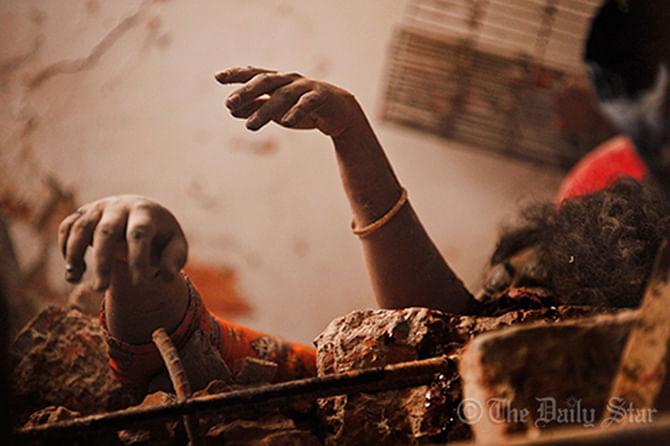
CAN the collapse of the nine-storey building in Savar yesterday be called an accident?
Unlike any accident, which catches victims off guard, people in decision-making positions at Rana Plaza had had warning about the problems of the building a day ahead of the tragedy.
Ignoring the warning, the authorities, including the building owner Sohel Rana, decided to keep the building open for business, a decision that has cost, as of filing of this report at 2:30am, 142 lives.
Interestingly, 11 people were saved by a quick decision by the top management of Brac Bank. The bank suspended operations of a branch located on the second floor of the building.
Rana Plaza at Bazar bus stand housed five garment factories from the third to the eighth floors.
On Tuesday morning, some cracks developed on some pillars and a few floors of the building following a jolt, causing panic among the people working there. They rushed out of the building and some even got injured in the process, said a number of garment workers and locals.
The industrial police visited the building that day.
“We had asked them [the building authorities] not to open the building but suspend operations of the factories after the cracks were noticed yesterday [Tuesday], but they ignored us,” Director of Industrial Police-1 Mostafizur Rahman told The Daily Star last night.
The warnings and instructions were all ignored.
The owners of the garments closed their factories around Tuesday noon but asked the workers to show up for work the next day. Click here to read full story.
Fight for life on under debris
100 more rescued alive; ceaseless efforts on to save trapped workers
Wasim Bin Habib, Helemul Alam and Hossain Biplob
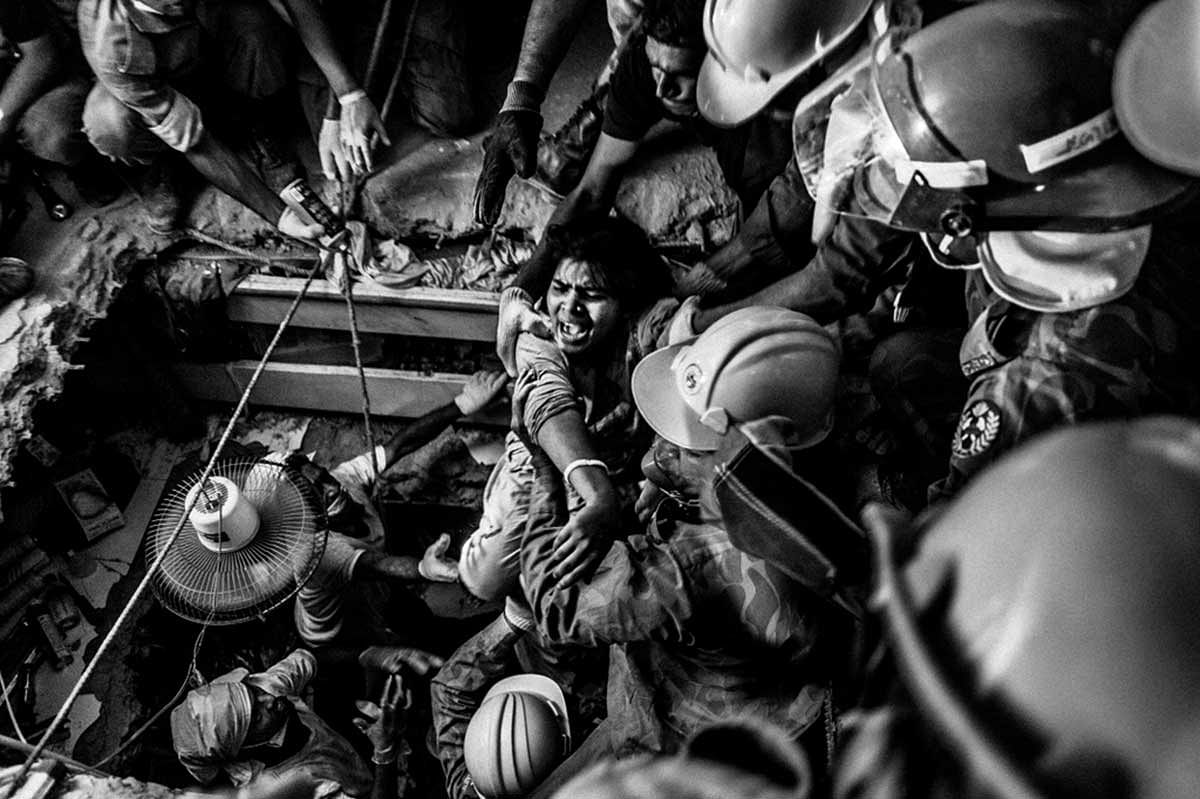
AROUND three days after the country’s worst building collapse, the hope of finding more survivors was not all gone, though a sickening stench of decaying corpses filled the air in Savar.
Some 100 people were dragged out of the wreckage yesterday.
The rescuers were relentless in their efforts as people trapped inside were alive by what could only be described as a miracle.
The death toll, meantime, rose to 315.
The rescue crews bored deeper into the rubble of the collapsed nine-storey Rana Plaza yesterday. They provided water, saline and oxygen cylinders whenever they found a survivor inside.
“We have supplied saline, torchlight and oxygen to a spot where around 24 people are still alive,” said Jashim Uddin, a rescuer.
Major General Chowdhury Hasan Sarwardi, general officer commanding of Nine Infantry Division, told reporters around noon that they could not remove the large slabs as many people were stuck inside. Their personnel made big holes to enter and bring out people, he added.
Since yesterday morning, news of more survivors spread among the relatives who gathered at Savar Bazar bus stand. For full story, click here.
Brave souls in Savar
No safety gear, no training, no proper equipment. But they have brave hearts to help the workers trapped in a mangled mess of concrete and rods
Masum Al Jaki
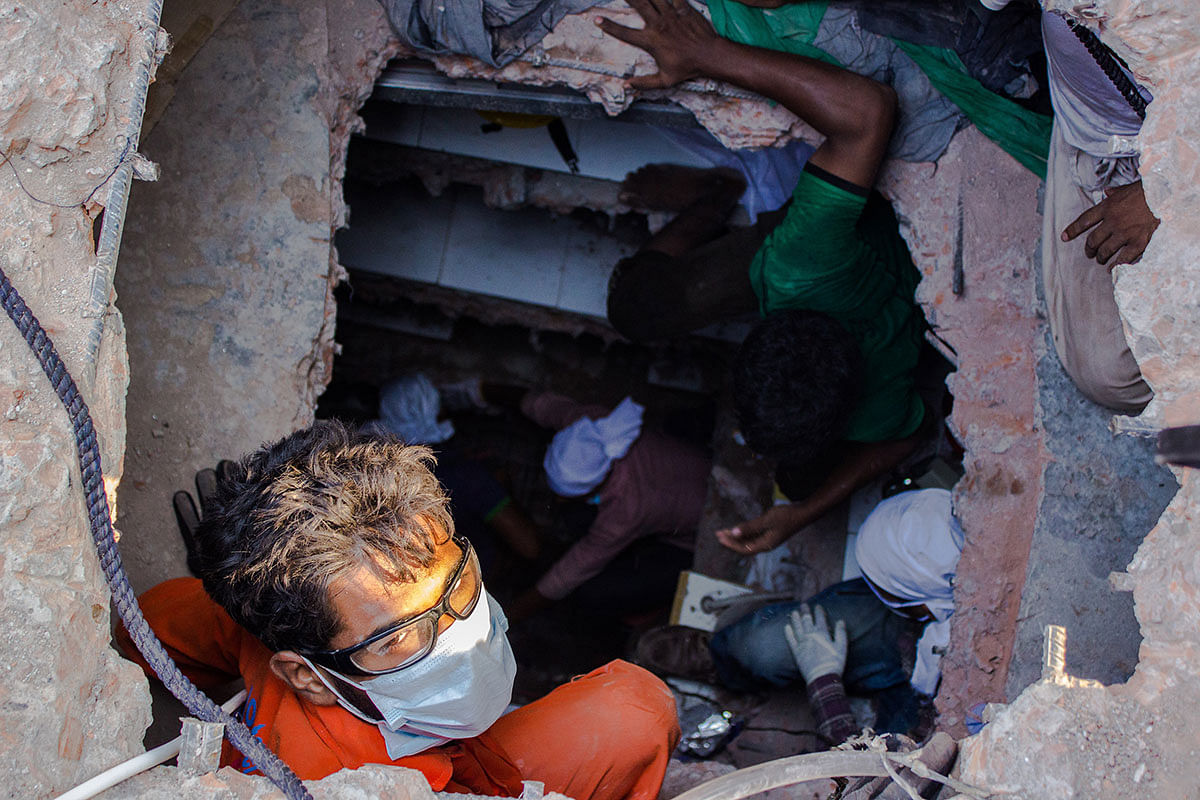
AS the Rana Plaza tragedy unfolded, many ordinary people joined the rescue effort. A large number of students, street vendors, garment workers and religious leaders joined hands with fire fighters, army and police.
In some cases, the unequipped civilians were seen leading the desperate operation putting their lives at risk.
They entered the building by breaking the walls, and pulled out people — dead or alive, while law enforcers were just busy controlling the crowd.
One of the brave men managed to rescue a pregnant woman alive. Another rescuer, without any medical knowledge, untangled a garment worker from the debris by cutting her leg. Click here to read about the brave souls.
Man behind 1,135 deaths captured
Rana blames it on factory owners
Staff Correspondent
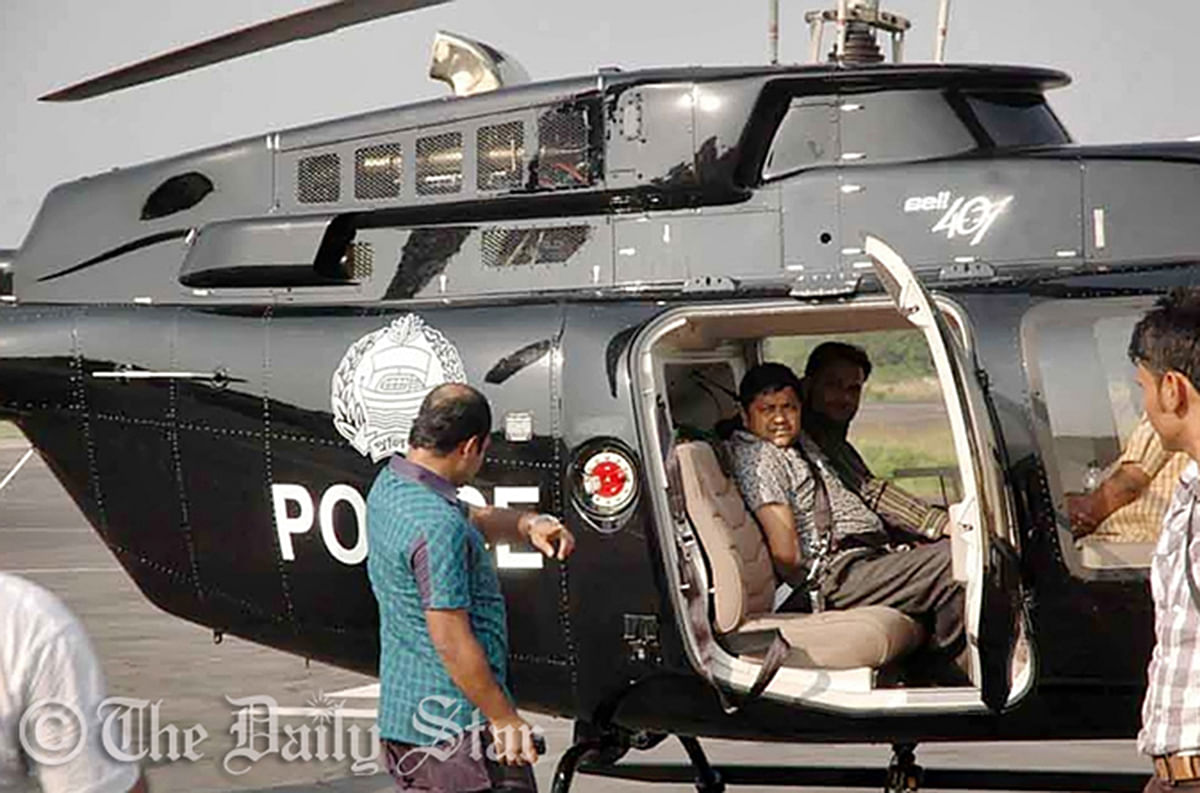
SOHEL Rana, owner of the Savar building that collapsed on Wednesday, leaving more than 381 dead and scores injured, was arrested in Benapole, Jessore, yesterday afternoon.
Rana went to Benapole to cross the border without a passport and was hiding at a human trafficker’s house in Ball Field area, about 0.5 kilometres from the Indian border, the Rapid Action Battalion said.
As soon as the news of the arrest was announced by Minister of State Jahangir Kabir Nanak, at the collapse site in the afternoon, locals burst into cheers and chanted slogans, “Hang Rana, Hang Rana!”
People in small groups brought out jubilant processions.
After Rana was brought to Dhaka in a helicopter around 5:00pm, Rab held a press briefing at its headquarters.
Man behind 377 deaths captured“He had been hiding in different places since Wednesday. We learnt through secret sources that he was hiding in Benapole,” Rab’s Director General Mokhlesur Rahman told the media.
The elite crime buster found two bottles of Phensedyl, lungis, caps, cigarettes, medicines and oral saline in a briefcase with Rana. Read full story here.
Miracle girl
Garment worker Reshma found alive under rubble on the 17th day of Rana Plaza rescue operation
Shamim Ashraf and Belal Hossain
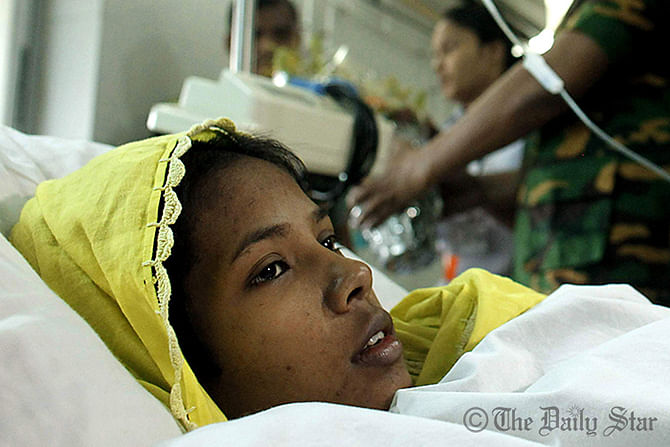
IT was a bright, sunny Friday afternoon. Weary of the unrelenting hours of retrieving rotting bodies from under the rubble, the rescuers seemed a bit burdened.
As they prepared to lift another big concrete slab of the first floor, a strong stench of corpses sickened the journalists standing a few yards away. Impatient, they asked the rescuers how long it would take to finish the job.
Herding the journalists, Major Moazzem Hossain asked them to follow him to the western side of the wreckage.
Standing there, a fatigued Abdur Razzak, an army warrant officer, just couldn’t believe what he saw next: a moving pipe, sticking out through a narrow hole of the first floor.
Awestruck, he screamed in joy: “Someone seems to be alive in there!”
All the weariness vanished and the rescuers raced to the point.
Miraculous as it may sound, removing the gravel they saw part of the face of a woman.
“Can you hear us? Are you okay? What’s your name?” shouted Hossain.
“Reshma,” responded a feeble voice. A little pause. “Please get me out of here. Please,” she then pleaded.
What could be a more gratifying moment than this for the rescuers who have been mingling with death since the country’s deadliest building collapse on April 24! Click here for full story.
No solace for kids of the missing
Helemul Alam and Belal Hossain Biplob
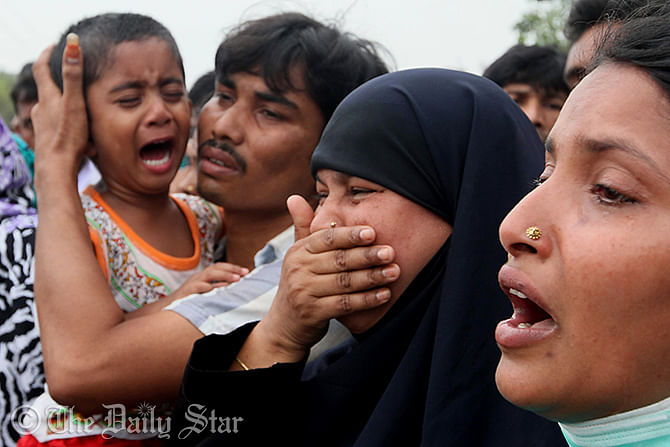
THOUGH the losses are irrecoverable, the families of the deceased and the injured in the Rana Plaza collapse are either getting compensated or receiving aid to start life anew. But what about the young kids whose parents are still missing after the end of the rescue drive, and therefore cannot claim any compensation, salary or seek financial help?
It is not known how many people are unaccounted for as authorities called off the rescue and search mission yesterday, 20 days after the disaster.
In most cases, these kids had single parent. So, they have become virtually orphaned and have nobody to take care of.
The father of five-year-old Sumon “disappeared” one month after his birth. Her mother took a job in the garment industry and was getting along until April 24 when the nine-storey building where her mother worked collapsed.
“Her husband did not return after leaving home one day. We could not trace him as we did not know his village home,” said Amena Begum, grandmother of Sumon.
She said her daughter was their only breadwinner as her husband could not do anything but selling milk from their domestic cows. Full story here.
Wait not over for them
One month into Savar tragedy, families of missing people still searching for their dear ones; 316 on missing list so far
Wasim Bin Habib
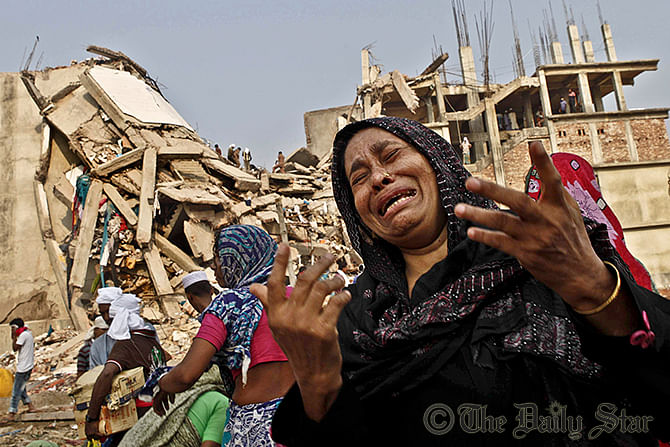
RELATIVES of those missing in the Rana Plaza collapse keep thronging different places in search of their loved ones, a month after the country’s deadliest industrial disaster that claimed more than 1,100 lives.
With photographs of their missing relatives in hands, some of them go to the local Upazila Nirbahi Office, others to the Savar Model Police Station and local hospitals. Yet others continue to gather every day at the collapse site with a sense of nothingness.
They knock at every possible door, wondering where else they can go to find at least the bodies for some kind of solace.
In their search efforts, relatives have so far filed 88 general diaries with Savar Model Police Station, police said.
The nine-storey Rana Plaza, which housed five garment factories, a shopping mall and a bank, came crashing down on the morning of April 24, killing at least 1,127 people, mostly garment workers.
Rescuers pulled out 2,438 people alive from beneath the rubble. Around 100 of them are still taking treatment at different hospitals, some with lost limbs.
Of the dead, 291 bodies out of 302 unidentified ones were buried at Jurain graveyard, according to Savar upazila administration. Full story can be read here.
US suspends GSP for Bangladesh
Revival of GSP hinges on labour standards improvement
Arun Devnath and Refayet Ullah Mirdha
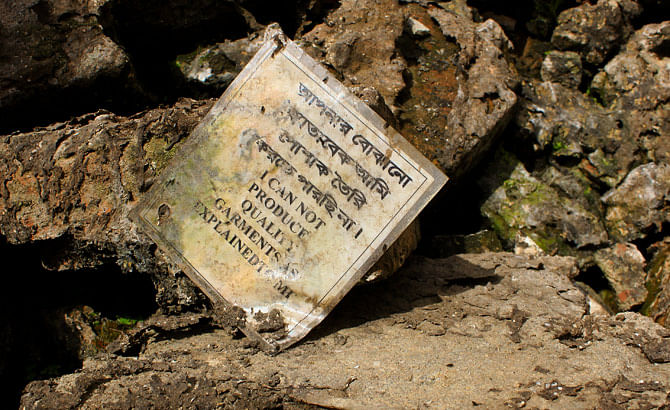
IN a chilling warning, the US yesterday suspended trade privileges for Bangladesh after a six-year review exposed “serious shortcomings” in safety and labour standards.
The decision will bring tariffs back on some of Bangladesh’s exports to US markets under the programme known as the Generalised System of Preferences. However, the scheme does not apply to Bangladesh’s main export: garment.
The suspension underlines the lack of progress by the government in improving factory conditions.
“I have determined that it is appropriate to suspend Bangladesh’s designation as a beneficiary developing country under the GSP programme because it is not taking steps to afford internationally recognised worker rights,” US President Barack Obama said in a message to the Congress.
The US government “has not seen sufficient progress” toward basic safety standards, despite its “close engagement and clear, repeated expressions of concern” with the Bangladesh government over the past few years, US Trade Representative Michael Froman said in a statement.
“The recent tragedies that needlessly took the lives of over 1,200 Bangladeshi garment factory workers have served to highlight some of the serious shortcomings in worker rights and workplace safety standards in Bangladesh.”
The Obama administration plans to initiate new discussions with the Bangladesh government on steps to improve the working environment so that GSP benefits can be restored and tragedies like the Rana Plaza collapse and Tazreen fire can be prevented, Froman said. “There is no particular timetable in mind.” Click here to read full story
Mozena: No blood-stained shirts, please
Star Business Report
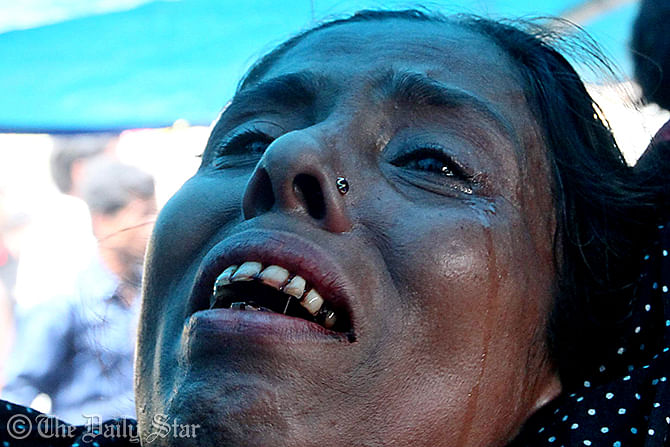
US Ambassador Dan W Mozena yesterday warned Bangladesh of the far-reaching impact of factory tragedies on the nation’s trade relations with American retailers and consumers.
“America will not buy shirts stained with the blood of Bangladeshi workers,” Mozena quoted a US congressman as saying at a meeting with him.
“The message was clear and powerful,” Mozena said just a day before the GSP benefits for exports, except for garments, to the US markets comes to an end.
The Obama administration suspended the trade privileges for Bangladesh in June this year, after a six-year review exposed “serious shortcomings” in safety and labour standards.
The decision bring tariffs back on some of Bangladesh’s exports to US markets under the scheme known as the Generalised System of Preferences (GSP).
On the horrific disasters of Tazreen Fashions fire and Rana Plaza building collapse, the ambassador said there simply cannot be any more such horrid disasters.
Mozena spoke at the inauguration of “Help Desk and US Product and Services Information Centre” at Dhaka Chamber of Commerce and Industry. He said time has come to transform the apparel sector of Bangladesh. Click here for full story.
Traumatised, left mostly uncared for
Sohel Parvez
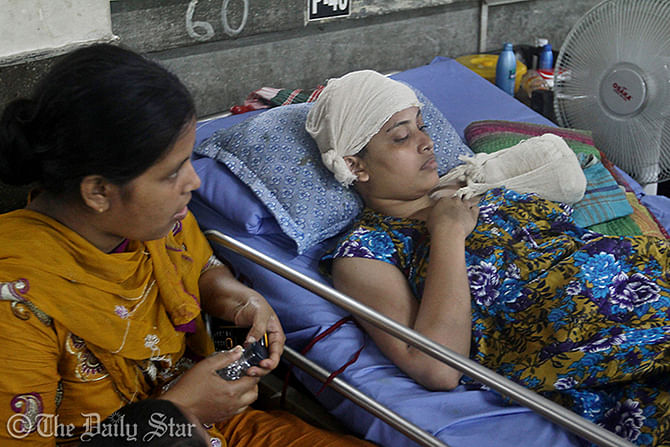
AT nightfall, Zulekha Begum goes to bed but quite often she does not get a full night's sleep. The traumatic scenes that unfolded before her eyes a year ago still haunt her, ghost-like.
The 30-year-old survivor of Rana Plaza collapse says the most frightening part of her dreams is when her dead colleagues come to her and blame her for not giving them water at the time of their death.
Zulekha, however, is not alone in her affliction. Some 24 percent of over 2,400 survivors and rescue workers are in the same boat as her, according to a study by ActionAid Bangladesh.
They either have difficulty sleeping or get uncontrollable fits, and not least, their phobia of multi-storey buildings, getting under concrete roofs and darkness. Several of them are hounded by the pong of dead bodies, while some randomly start to behave abnormally.
The condition has been barring them from leading normal lives and getting re-employed a year after the tragic event, the deadliest industrial accident in the nation's history. And, in the odd chance that they find work, they have to quit before long: the haunted memories severely encumber their performance.
Unfortunately, the issue, which, psychiatrists say, can rouse suicidal tendencies, never got any attention from the government. While some international donors and nongovernmental organisations came forward to provide psychological support, the operations petered out after some time. For full story, click here.
Survived, only to suffer
Sohel Parvez and Md Fazlur Rahman
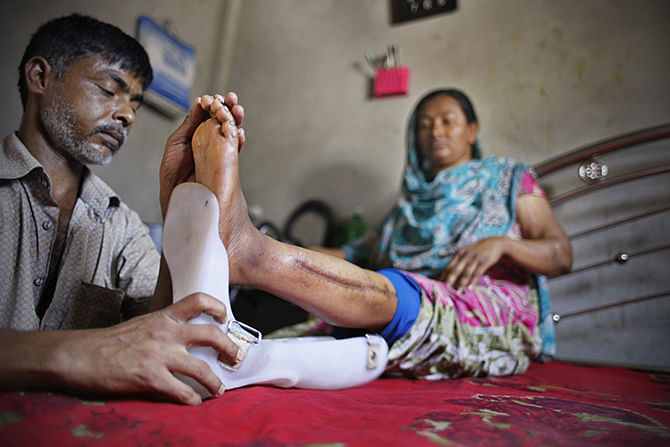
THIRTY-five-year-old Feli limps to her rented room from the small grocery store she opened three months ago with the help of the Centre for Rehabilitation of the Paralysed (CRP).
One of the 1,500 pulled out alive from the rubble of Rana Plaza, she has a paralysing feeling in her left leg and is unable to bend her left arm. Her physical weaknesses have left her dependent on her husband to run the store and for household chores.
Feli's husband Hasu Miah, 40, had to quit his job as a caretaker at a house nearby to take care of his wife and 11-year-old daughter. The family's financial hardships have deepened as their monthly income has dropped to a third of Tk 18,000 that they earned collectively a year before.
“It has been two months that we cannot pay rent for our home and the grocery shop. Our daughter's school fees are also due,” said an ailing Feli, who has no surname.
She had been trapped under a broken roof and beam for three days before she was rescued.
One year has passed since the deadliest apparel industry disaster in Savar on April 24 last year that killed over 1,134 workers and left nearly 2,000 injured. The families that had migrated from their rural homes in the hope of a better life are struggling to make ends meet. Click here for full story.
Supervising Editor: Inam Ahmed
Editor: Shamim Ashraf
Copyediting: Shamim Ashraf, Moyukh Mahtab
Photographs: Moyukh Mahtab, Rashad Ahmed
Photo contributors: Abu Syeed Sumon, Anamika Chowdhury, Anik Rahman, Aninda Kabir Avik, Ismail Ferdous, Israr Zayan, Jewel Paul, Mahmud Amin, Mohiuddin Saifullah Shuvro, Rahul Talukder, Sakib Chaklader, Sharifuzzaman Ripon, Tasfiq Mahmood
Videos: Moyukh Mahtab, Fardaus Mobarok
Photo and Video Editing: Moyukh Mahtab, Sam Jahan, Patrick DeSutter
Research: Sam Jahan, Zaid Bin Kalam
Design and development: MH Sunny

 For all latest news, follow The Daily Star's Google News channel.
For all latest news, follow The Daily Star's Google News channel. 



Comments